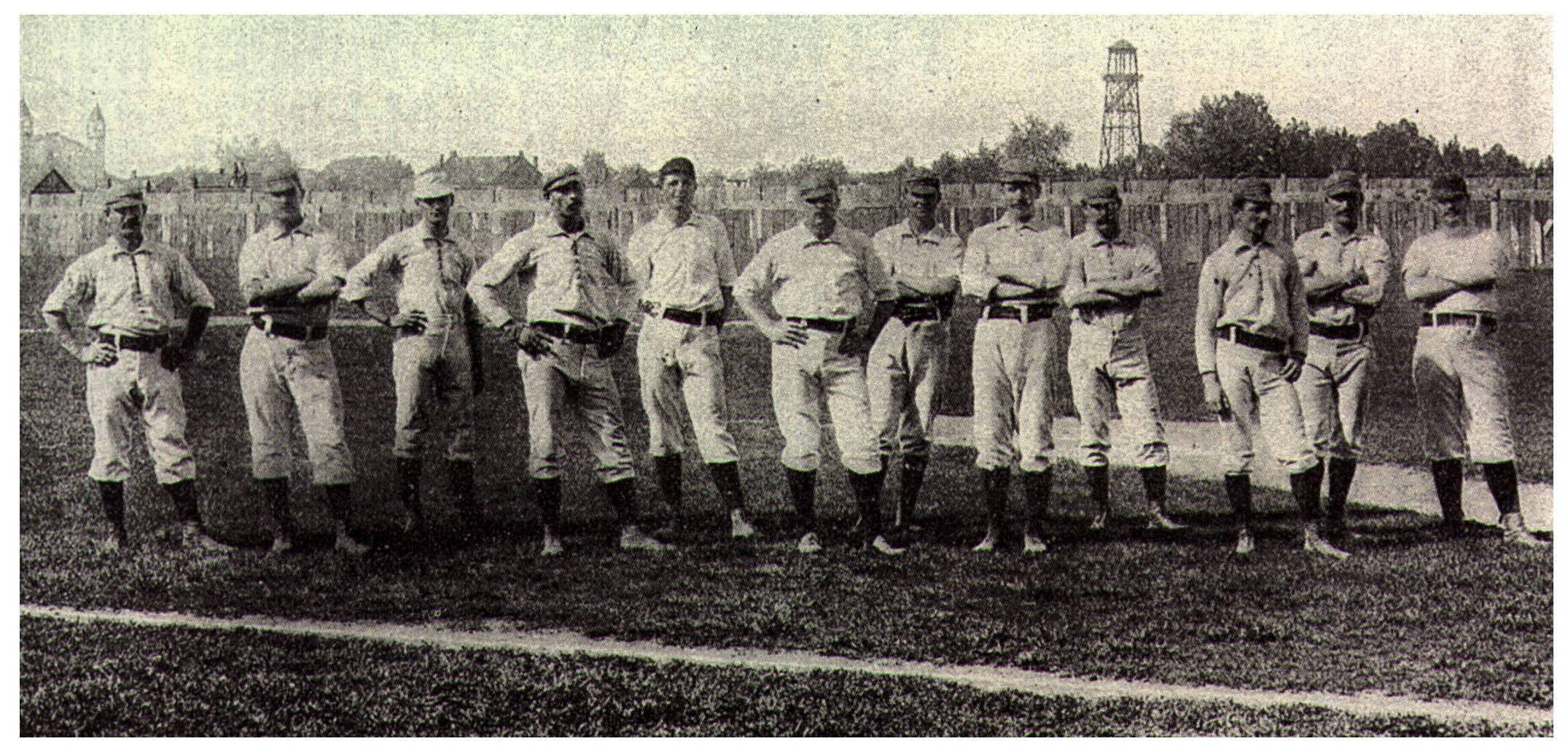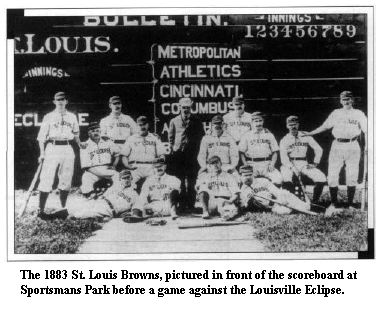
Photo from "The National Game" by Alfred H. Spink (1910).
 |
| The 1882 Browns, from left to right: Edgar Cuthbert,
William Gleason, Charles Morton, Oscar Walker, Charles Comiskey, Jack Gleason, Daisy Dorr,
Harry McCaffery, Tom Sullivan, Joe Crotty, Edward Brown, George McGinnis. Photo from "The National Game" by Alfred H. Spink (1910). |
Opening Day for the American Association was May 2, 1882; the Browns started the season home at Sportsman's Park with a 9-7 win over Louisville. The lineup featured Bill and Jack Gleason, the first brothers to play together on the same infield in the major leagues, and Jumbo McGinnis, the starting pitcher who was reportedly eighteen years old in 1882. He went on to win 25 games for the Browns during the season, 4th highest in the Association that year. He would win 28 for the Browns in 1883 and 24 more in 1884, but only another 25 after that in three more seasons, and his career was over after the 1887 season. Ned Cuthbert, a veteran of 7 seasons, including two with the old Brown Stockings, came out from behind the bar to play left field and manage the Browns in 1882. At 1B that opening day was 22-year-old Charlie Comiskey, playing in his first major league game after several seasons with the Dubuque Rabbits. Comiskey was never more than an average ballplayer, but in just a few years he would be the leader of the Browns juggernaut. Comiskey drove in the Browns' first run, Jack Gleason. The team was a game behind the Cincinnati club in late June, eight games over .500, but dropped off the final seven weeks of the season and finished a fifth in the six-club league.
St. Louis Browns' Opening Day lineup for May 2, 1882
| Jack Gleason | 3B |
| Bill Gleason | SS |
| Oscar Walker | CF |
| Charlie Comiskey | 1B |
| Bill Smiley | 2B |
| Sleeper Sullivan | C |
| Ned Cuthbert | LF |
| Jumbo McGinnis | P |
| George Seward | RF |
For the 1883 season, Von der Ahe handed the manager's reins to Ted Sullivan, who had
signed Comiskey to his first professional contract in Dubuque. He also signed Tony
Mullane, a 30 game winner with Louisville the year before as a rookie. The Browns
were in first as late as early September and remained in the race until the end. As
the season wound down, they faced the Philadelphia Athletics, whom they trailed by
2 1/2 games, in a critical three game series at home. Philadelphia won game one 13-11
 as the Browns made 12 errors (5 by 3B Arlie Latham in his first season in St. Louis).
The Browns won the second game of the series 9-8, but lost the third game 9-2 and
finished the season at 65-33, just one game back despite winning their final three
games. Mullane (35-15) and McGinnis (28-16) started 94 of the 98 for the Browns. Sullivan
quit late in the season after several clashes over Von der Ahe's interference, and he
was replaced on an interim basis by Charles Comiskey. Comiskey, in his second season
with the Browns and in the major leagues, would take over the Browns again late in the
1884 season and remain as its manager for the remainder of the club's tenure in the
American Association, with the exception of the 1890 season during the Player's Rebellion.
Sulliven would `manage again in St. Louis in 1884 with the Maroons
in the Union Association.
as the Browns made 12 errors (5 by 3B Arlie Latham in his first season in St. Louis).
The Browns won the second game of the series 9-8, but lost the third game 9-2 and
finished the season at 65-33, just one game back despite winning their final three
games. Mullane (35-15) and McGinnis (28-16) started 94 of the 98 for the Browns. Sullivan
quit late in the season after several clashes over Von der Ahe's interference, and he
was replaced on an interim basis by Charles Comiskey. Comiskey, in his second season
with the Browns and in the major leagues, would take over the Browns again late in the
1884 season and remain as its manager for the remainder of the club's tenure in the
American Association, with the exception of the 1890 season during the Player's Rebellion.
Sulliven would `manage again in St. Louis in 1884 with the Maroons
in the Union Association.
The 1884 season saw three major leagues competing for the first time, with the Union Association shooting onto the scene for its only campaign. The Union Association was the creation of Henry Lucas of St. Louis, and his club, the St. Louis Maroons looked to be the best club in that league. The Association expanded to twelve teams for 1884, adding clubs in Brooklyn, Indianapolis, Washington, and Toledo. (It had expanded to eight clubs for the 1883 season, adding clubs in Columbus and New York.) This move proved to be a failiure, as the Washington club folded before the season ended and the Indianapolis and Brooklyn clubs languished near the bottom of the standings all season. The Washington club was replaced by a team in Richmond, Virginia for the rest of the season. The Toledo club finished at 46 wins and 58 losses, with Tony Mullane getting 37 of the wins, but also 27 losses. Mullane wound up with Toledo in 1884 as a result of the machinations of Von der Ahe. Before the season, Mullane jumped his contract with the Browns and signed with the rival Maroons for $2500 after the the Browns offered only $1900. Von der Ahe was worried that Mullane would draw local fans away from his Browns, so he convinced the other Association owners to cooperate and not bid on Mullane, and then he arranged for him to sign with the expansion Toledo club, who figured to be no competition for the Browns. After Mullane's first game back in St. Louis with the Toledo club, the Maroons obtained a court order to prohibit him from playing in St. Louis again. The court order remained in effect until 1887. After the 1884 season, Mullane signed with Cincinnati, and Von der Ahe spearheaded the effort to get him banned for the 1885 season for jumping his original contract with the Browns.
The Maroons were one of the best clubs in baseball in 1884, but the Browns were able to remain competative at the gate and on the field. Jimmy Williams, previously the secretary of the Association, was hired to manage the club, but not before he orchestrated the signing of Tip O'Neill away from the New York Metropolitans (AA). O'Neill had been released by the National League's New York franchise and then promptly signed by the Mets, who were not so coincidentally owned by the same group. Williams voided the contract, and then signed O'Neill for the Browns after he became the manager. O'Neill was the center of the Browns offense for the remainder of the decade, but in 1884 he split time between pitching and the outfield. In early July, the club was in second place, one of five teams within two games of the first place Louisville club. The club bolstered its pitching for the pennant race, signing Dave Foutz and Bob Caruthers from the Northwestern League in late July. (The Northwestern League, the third party in the National Agreement of 1883 which brought peace between the NL and the AA, folded late in the 1884 season as a casulty of the war with the Union Association.) Foutz and Caruthers won 22 games down the stretch, but the club faded on a late-season road trip. Manager Jimmy Williams resigned following the late-August slump, also due to conflicts with Von der Ahe. Once again the manager's job passed to Comiskey, except this time it was permanent. Comiskey would make the Browns the most dominent team in the Association in the following years. Without him in the 1890's, the Browns' fortunes reversed dramatically. Comiskey went on to be a major power in the new American League well into the next century, and he was enshrined in the Hall of Fame not for his contributions on the field, but for his record as a manager and as an owner. The Browns finished fourth, 8 games out but only a game and a half behind the second place Columbus club. The New York Metropolitans were the surprise league champions for 1884.
1884 Browns stats
1884 Maroons stats
Following the 1884 season, the National League sought to add Lucas' Maroons in place of the Cleveland Blues, who folded after losing a large portion of its players to Union Association raids. The National Agreement, signed in the fall of 1883 by the two major leagues and the Northwestern League, prohibited the placement of new franchises by one league into cities which were controlled by one of the other leagues. However, before the 1883 season, the National League moved franchises from Troy and Worcester into Philadelphia and New York, and the two leagues had shared those two cities since, so a precedent had been set. The National League wanted to install a franchise in St. Louis to weaken the Association, which it never truely accepted as an equal. In order to complete the arrangement, they had to get permission from the Association and Von der Ahe. After a meeting between Lucas and Von der Ahe in St. Louis, the Maroons were members of the National League and the Union Association collapsed. While the Maroons were a strong club in 1884, they languished at the bottom of the NL for the next two seasons, and they were unable to compete with Von der Ahe's Browns. The Browns had a winning club, could sell beer at games, charged only $0.25 for admission, and could play games on Sundays. Despite gaining some concessions from the NL on admission prices, the Maroons still could not draw fans away from their local rivals. They played their final game against the Browns - an exhibition game after the 1886 season - and then quietly folded. The three tenants of the American Association which led it to be branded the Beer and Whiskey League also enabled the Browns to dominate its St. Louis rival.
Part 1: The origin of the American Association
Part 3: The glory years, Act I (1885-1886)